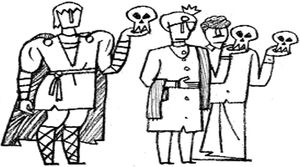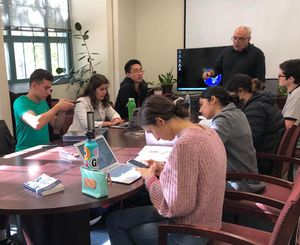An update from the front lines of the Core classrooms! This week, students are exploring Hamlet, and discovering what it means to remediate a text.
 Core students know better than anyone that some stories strike such a chord with the human experience that they continue to be told throughout history. Storytellers have always taken source material and adapted or re-imagined it for a new medium, bringing it to life in a new way. In modern times, this reimagining can transform a book to film, drama to social media, poem to graphic novel, and more. Scholars call this a remediation, and while remediation is having getting attention across the academic world, it has a special place in the heart of the Core.
Core students know better than anyone that some stories strike such a chord with the human experience that they continue to be told throughout history. Storytellers have always taken source material and adapted or re-imagined it for a new medium, bringing it to life in a new way. In modern times, this reimagining can transform a book to film, drama to social media, poem to graphic novel, and more. Scholars call this a remediation, and while remediation is having getting attention across the academic world, it has a special place in the heart of the Core.
What’s so special about remediation in Core? Well, as we work with the foundational texts for human thought, we’re not the first ones to try and think about them in new ways. Even the authors we read are building upon other texts and older authors, trying to experiment with new media. Students in CC201 are learning this now through Hamlet, as Professor Brian Walsh argued in his lecture this semester:
Shakespeare himself, as well as his characters, are often explicitly engaged in these dialogues with other authors. And while Don Quixote is a contemporary work for him, more often he and his characters are considering their relationship to tradition, to past authors. In many scholarly conceptions of the Renaissance, this idea of how do we relate to tradition is the central or defining challenge for the period’s artists and intellectuals… So that turns us to the question, how does Hamlet, both the play and the character, respond to tradition?
Authors have always had to contest with tradition and the thinkers who came before them. There is plenty of evidence of this in Core– Dante provides a great example, as he incorporates and builds upon characters and historical figures who came before him in the Divine Comedy. Just as Core authors thought of new ways to conceptualize those who came before them, remediation offers modern readers a new way to conceptualize the texts themselves.
Returning to Hamlet specifically, Professor Walsh offers further examples of remediation of the play itself. A 2014 Bollywood adaptation of Hamlet called Haider gained attention for its depiction of the insurgency in the Kashmir of the 1990s. This remediated backdrop allowed the director, Vishal Bhardwaj, to make a statement on the human rights abuses of the armed conflict and start a conversation about the controversial topic. Not only has the play become a movie, but the play has taken on new importance related to its new, remediated themes.
Changing the media allows the source material to take on new meaning, as it does in the project Hamlet: A Digital Remediation. This version takes place entirely through Facebook, Instagram, and Tumblr, acting out Hamlet as if the characters were modern-day people communicating on social media. While this provides an experiment and commentary on social media, the authors of this remediation also offer how adapting foundational texts is a valuable act:
Fanfiction and other forms of remix culture can be valuable tools for reclaiming narratives in which minority voices are downplayed or nonexistent. The original Hamlet, although not written exclusively for upper-class audiences, does contain primarily white and straight characters and takes place in a privileged, upper-class world. Retelling the story in a new form is an opportunity to add more diverse voices to a narrative that is deeply embedded in Western culture.
Remediation allows the same important stories to be told, but for a new generation and new mode of thought. As a program that works almost entirely with texts from a different age, remediation offers the Core Curriculum a special opportunity to get our fingers in the clay of these texts.
 Thanks to the initiative of Professor Jason Prentice, the Digital & Multimedia Coordinator for Core, Core students now have the opportunity to try their hands at remediation. Last Spring marked the inaugural semester of our “Digital Core” classes, where students can expand upon their knowledge of a Core text by studying how the text has been recreated throughout history, and even create their own versions themselves, from Genesis to Plato to Hamlet.
Thanks to the initiative of Professor Jason Prentice, the Digital & Multimedia Coordinator for Core, Core students now have the opportunity to try their hands at remediation. Last Spring marked the inaugural semester of our “Digital Core” classes, where students can expand upon their knowledge of a Core text by studying how the text has been recreated throughout history, and even create their own versions themselves, from Genesis to Plato to Hamlet.
In this semester’s Digital Core class, Professor Sassan Tabatabai is leading his students on journey to recreate The Conference of the Birds in an online multimedia graphic novel form. With remediations, the possibilities are endless.Catching him in the hall, we asked Prof. Tabatabai why he thinks this act of remediation in general, and his new CC320 class in particular, are important. He replied:
The Conference of the Birds has always had an afterlife in art, in music, in dance– a digital remediation would just be the logical progression to that.
Remediation is something people have been doing throughout history, but with the onset of digital methods and media, we have greatly expanded the possibilities for rethinking foundational texts. While this provides opportunities for expanding the diversity and reach of texts, it also invites more problems, like appropriation, cultural disruption and dissipation. Overall, this is just an evolution of the way we think about the writings that came before us, and a chance to show them in a new light.
